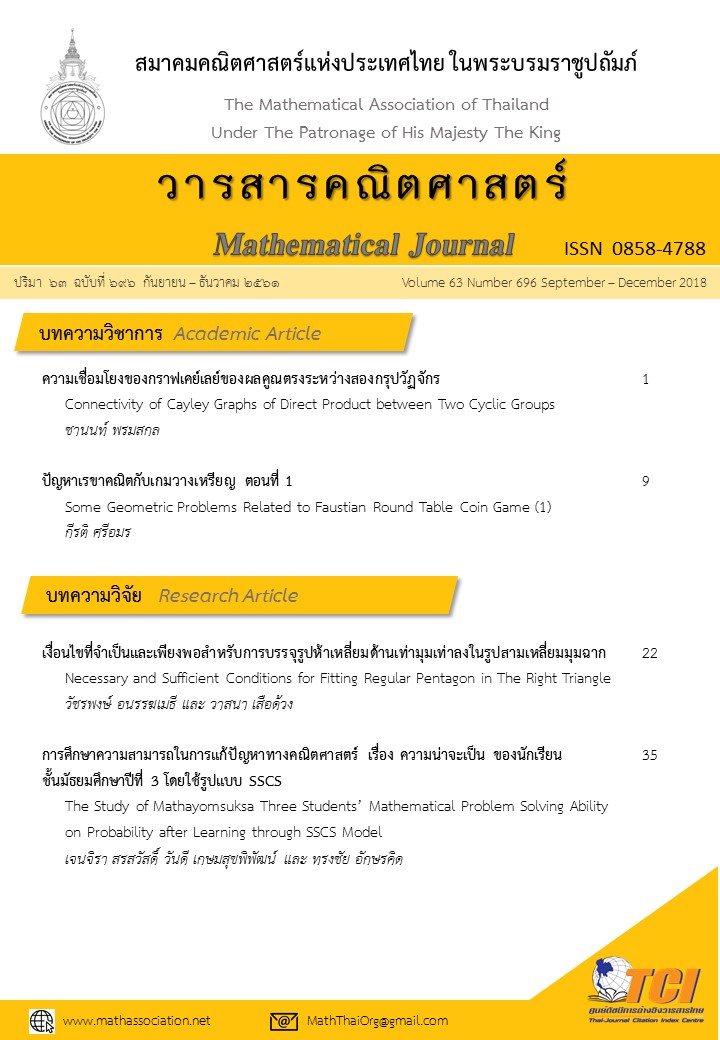The Study of Mathayomsuksa Three Students’ Mathematical Problem Solving Ability on Probability after Learning Through SSCS Model
Main Article Content
Abstract
The objective of this research was to study problem solving ability on “Probability” of Mathayomsuksa three students after learning through SSCS model. The participants of this study were 48 Matayomsuksa 3 students at a school in Bangkok in the academic year 2017. The research instruments included: 1) 10 lesson plans on Probability based on SSCS model and 2) the mathematics problems solving test on “Probability”, which was 5 – item essay test. The students’ scores from the mathematics problem solving test were analyzed by using descriptive statistics, mean, standard deviation, and percentage. The percentage of the average score was compared to the criteria, 60 percent. The research revealed that after learning through activity based on SSCS model, the students’ problem solving average score was higher than 60 percent. Most of the students could understand problems and solve problems correctly.
Article Details
References
Ministry of Education. (2008). Basic Education Core Corriculum B.E. 2551 (A.D. 2008). Bangkok: The Agricultural Cooperative Federation of Thailand. Limited.
[2] นริศรา สาราญวงษ์. (2558). การจัดการเรียนรู้ด้วยรูปแบบ SSCS เพื่อพัฒนาความสามารถในการแก้ปัญหาทางคณิตศาสตร์และผลสัมฤทธิ์ทางการเรียนคณิตศาสตร์ เรื่องบทประยุกต์ สำหรับนักเรียนชั้นประถมศึกษาปีที่ 5. (วิทยานิพนธ์ศึกษามหาบัณฑิต, มหาวิทยาลัยบูรพา).
Narisara Samranwong. (2015). Learning Management by SSCS model for developing Mathematics Problems Solving Ability and Mathematics Learning Achievemant of Pratomsuksa 5 Students. (Master’s Thesis, Burapha University).
[3] สันนิสา สมัยอยู่. (2554). ผลการเรียนรู้แบบ SSCS ที่มีต่อความสามารถในการแก้ปัญหาและการสื่อสารทางคณิตศาสตร์ ของนักเรียนชั้นประถมศึกษาปีที่ 2 เรื่องการประยุกต์ของสมการเชิงเส้นตัวแปรเดียว. (ปริญญานิพนธ์การศึกษามหาบัณฑิต, มหาวิทยาลัยศรีนครินทรวิโรฒ).
Sunnisa Samaiyoo. (2011). The Effects of Organizing SSCS Model on Mathematical Problem Solving and Communication Abilities of Mathayomsuksa 2 Students on The Application of Linear Equations in One Variable. (Master’s Thesis, Srinakharinwirot University).
[4] สิริพร ทิพย์คง. (2545). หลักสูตรและการสอนคณิตศาสตร์. กรุงเทพมหานคร: พัฒนาคุณภาพวิชาการ.
Siriporn Thipkong. (2002). Curriculum and Instruction in Mathematics. Bangkok: Institute of Academic Development.
[5] สุกัญญา สุมโน. (2554). การศึกษาความสามารถในการแก้โจทย์ปัญหาคณิตศาสตร์ เรื่อง ร้อยละ ของนักเรียนชั้นประถมศึกษาปีที่ 6 โดยใช้รูปแบบ SSCS โรงเรียนวัดหนองแขม (สหราษฎร์บูรณะ) กรุงเทพมหานคร. วารสารคณิตศาสตร์ โดย สมาคมคณิตศาสตร์แห่งประเทศไทย ในพระบรมราชูปถัมภ์, 55(623 - 625), น. 63 - 72.
Sukanya Sumano. (2011). The Study of Mathematics Ability in Solving Word Problems on Percent of Prathomsuksa Six Students by Using SSCS Model at Watnongkhaem (Saharatburana), Mathematical Journal by The Mathematical Association of Thailand under the Patronage of His Majesty the King, 55(623 - 625), p. 63 - 72.
[6] สุภาพร ปิ่นทอง. (2554). การเปรียบเทียบความสามารถในการแก้ปัญหาทางคณิตศาสตร์ เรื่อง อสมการและเจตคติต่อการเรียนวิชาคณิตศาสตร์ ของนักเรียนชั้นมัธยมศึกษาปีที่ 3 ที่ได้รับการสอนโดยใช้รูปแบบ SSCS และการสอนโดยใช้เทคนิค KWDL. (ปริญญานิพนธ์การศึกษามหาบัณฑิต, มหาวิทยาลัยศรีนครินทรวิโรฒ).
Supaporn Pinthong. (2011). A Comparison of Mathayomsuksa 3 Students' Mathematical Problem Solving Ability in Inequality and Attitude towards Mathematics Learning by Using SSCS Model and KWDL Technique. (Master’s Thesis, Srinakharinwirot University).
[7] Anderson, L. W., and Krathwohl, D. R. (2001). A Taxonomy for Learning, Teaching, and Assessing: A Revision of Bloom’s Taxonomy of Educational Objectives. New York, USA: Addison Wesley Longman.
[8] Lester, F. K. (2013). Thoughts about research on mathematical problem solving instruction. The Mathematics Enthusiast, 1(10), p. 245 – 278.
[9] Pizzini, E. L., Shepardson, D. P., and Abell S. K. (1989). A rationale for and the development of a problem solving model of instruction in science education. Science Education, 5(73), p. 523 - 534.


